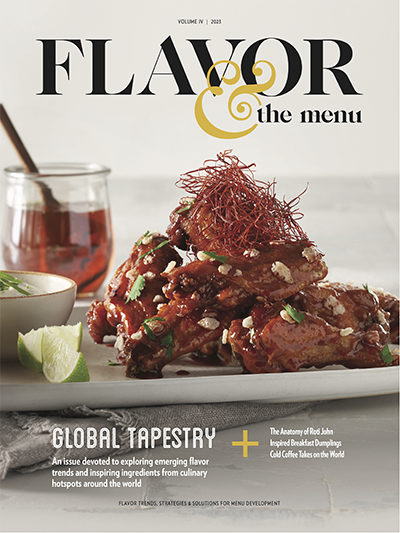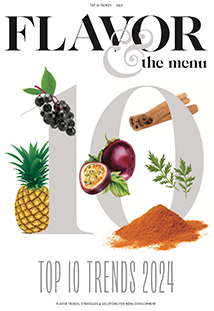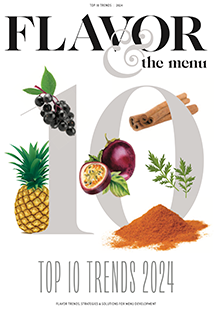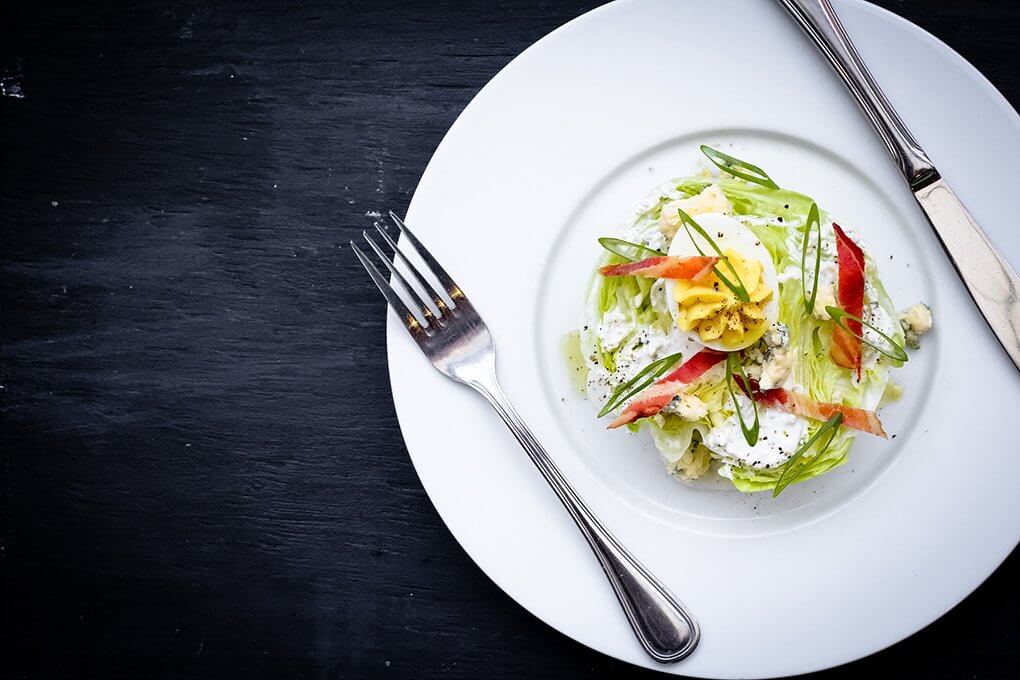Salads have been watching the bowls trend with great interest. With a little envy, too. Bowls have skyrocketed over the last few years, firmly affixing themselves on menus as exciting options, boasting layers of textures and flavors. Salads, meanwhile, have stayed somewhat the same. Menu stalwarts. Weekday lunch choices when diners are trying to be “good.” Bowls are jazz hands. Salads are Muzak. But salads know they can do what bowls do—they just want their shot. They can be thoughtfully constructed; they can incorporate a variety of flavor-forward ingredients. And they can bring much-needed innovation to a category ready for a makeover.
“I think bowls, as well as the broader impact of world cuisines, have changed up what people expect out of a bowl and, in turn, a salad,” says Maeve Webster, president of Menu Matters, an independent foodservice consultancy. “Bowls tend to do a far better job than salads have, traditionally, in thoughtfully marrying flavors, textures and visual impact. Of course, some salads do this well, but many come off as a bunch of stuff thrown on top of lettuce—not overly appealing and easily overlooked with all the innovation happening in other categories. Now, with the increased focus on superfoods and functional eating, the impact of protein demand, and interest in bold, complex flavors, salads are undergoing an evolution.”
The bowl movement, then, along with the new mindful mission of flavor-building and layering, has cleared the path for this new age in salads. Chefs reinvigorating the category are turning to crisper greens, like romaine and iceberg, as their foundation for creative salad builds. Consider the When in Romaine salad by José Andrés at Beefsteak, with five locations in the Mid-Atlantic. It starts with romaine, and for heightened flavor experiences within the salad, incorporates a cucumber salad, seaweed salad and toasted seaweed. Cherry tomatoes, radish, sprouts and scallions round out the profile. The house Wedge at Maple & Ash in Chicago sees a crisp iceberg wedge topped with spicy onion rings, marinated tomatoes and glazed bacon, all dressed with a combination of blue and ranch dressings.

The Harvest Salad at TR Fire Grill is a study in thoughtfully constructed flavor and texture play—from the batter-dipped Brussels sprouts and smoked asparagus to the roasted tomatoes and golden beets.
Not only do these crisp greens lend firmer structure to a larger mix of ingredients, they also deliver the crunch. Romaine and iceberg are key to this trend, making the pendulum swing from tender, soft greens, like baby lettuces and spring mixes, to crisp, refreshing ones. Tender greens have held the limelight for a number of years now, loved for their glowing health halo and earthy, vegetal flavor profiles. But in making them the star of salads, chefs left behind the crunch. Now, the crunch factor is back, dialing up the satisfaction of these modern salads while serving as sturdy springboards for crowd-pleasing combinations. Some growers are even introducing new lettuce hybrids that boast the crunch of iceberg with the nutrient density of romaine, making that classic salad component even more appealing.
Crisp lettuce is also generally favored by younger consumers. This preference is helping stoke interest in today’s salad innovations. “Until recently, if you wanted to be sophisticated, you would go with baby greens,” says Dan Long, chief culinary officer and co-founder of Mad Greens, a salad-themed fast casual based in Golden, Colo., with around 30 units nationwide. “That was a signal to the world that you were serious and sophisticated. Now, you can use iceberg and romaine and still be serious—as long as the build has creative ingredients with a cohesive flavor story. That’s where the perception has changed.”
Crunchy greens also deliver satiety. “Consumers are tired of the relentless messaging around leafy greens,” says food trends analyst Kara Nielsen. “With romaine and iceberg, the water content is higher. Crisp salads make you feel like you’re eating something. Some of them also lend themselves well to grilling—fire and char make for an enticing salad.” Charring or grilling heartier lettuces also helps build interest and complexity in a salad, which is at the heart of this emerging trend.

An intentional approach marks today’s salad. At The Vine in New York, Laurent Tourondel creates a masterfully balanced Vegetable Chopped Salad with modern ingredients like baby beets and radishes.
Salads with Intent
Mindfulness is an overarching theme informing a number of flavor trends today. Bowls, certainly, reflect a thoughtfulness of intent. The veg-centric movement also showcases that careful intention. In both instances, flavors are coaxed out through charring, grilling, roasting, glazing, pickling and braising. Textures are juxtaposed in ways that prevent palate fatigue, from a soft layer of quinoa or burrata to a crunchy layer of pickled carrots to a smooth drizzle of chimichurri. That modern mindfulness is starting to be applied to salads.
“The modern salad build is an explosive trend,” says Pam Smith, nutritionist and culinary consultant. “There hasn’t been much development around salads, and now bowls and veg-centric have intersected, showing not only what can be done, but what diners are looking for. A Southwestern salad on a menu today, for instance, is more composed—maybe a crispy romaine heart or baby iceberg tossed in a buttermilk-chipotle icebox dressing, then layered: a salsa verde swiped on the bottom of the salad plate, black beans, roasted corn, crispy tortilla and avocado pico de gallo,” she adds. “It becomes an integrated flavor experience.”
Mad Greens offers more than 40 salad-building ingredients, many of them demonstrating the modern bent of this trend—from Olomomo Cherry Vanilla Pecans and roasted broccoli to grilled peri peri shrimp and honey smoked salmon. “Often, a lot of thought isn’t given to the lettuce itself, and how it interacts with other ingredients,” says Long. “That’s such an important part of this trend today. The default can be spring mix or arugula, and those can be great against pork belly, for instance. But with the trend toward more nuanced dressings, like a yuzu vinaigrette, then romaine might be a better choice.”

The Wedge Salad receives its own menu section at Bristol’s Burgers in Hollywood, Fla., offering three versions, including a Greek wedge with chickpeas, olives and feta.
Sweetgreen, with 58 units nationwide, is another fast casual in the salad space that’s helping to move this trend forward. Its Hummus Tahina Salad showcases a mindful build with layers of interesting, flavor-forward ingredients and textures.
It starts with chopped romaine, adds shredded kale, herb falafel, feta, tomatoes, red onion, cucumber, za’atar breadcrumbs, housemade hummus—all dressed in a cucumber-tahini-yogurt dressing.
Garden Bar, a fast-casual salad concept with six units in Portland, Ore., offers made-to-order salads with an array of nontraditional toppings. Its Cowboy Up Salad illustrates how modern salads are borrowing from bowls for textural play: crisp romaine, steak, red onion, roasted chickpeas, chimichurri and roasted potatoes, finished with a blue cheese vinaigrette.
“There’s a cost advantage with using romaine and iceberg that shouldn’t be discounted when we talk about the opportunity within this trend,” says Michael Slavin, directory of culinary & menu innovation for the Houlihan’s, J. Gilbert’s Wood-Fired Steak and Bristol Seafood concepts based in Leawood, Kan. “They get the most weight per pound; they hold up longer. And they’re the greens that support all of these modern toppings we’re talking about, like warm potatoes or roasted vegetables.” Slavin recently added a Mediterranean side salad to the menu at Houlihan’s, which starts with a swipe of pesto on the plate, topped with spiralized zucchini, Kalamata olives, roasted artichokes, fresh mint and basil, dressed in a lemon-thyme vinaigrette. “I’m not a fan of homogeneous flavor experiences,” he says. “If I mixed the pesto into the salad, then it doesn’t offer its own unique flavor. By strategically placing it as its own element, the guest has a pleasant surprise when their fork hits that pesto. It makes it interesting and memorable.”

An underpinning of pesto makes the Mediterranean Side Salad at Houlihan’s memorable. Spiralized zucchini adds on-trend textural interest.
Crisp greens help carry the weight of more complex flavor builds. At TR Fire Grill in Winter Park, Fla. (Tony Roma’s new sister concept with a modern American menu), romaine stars in several of its salad offerings. “When we were creating these salads, we wanted firmer lettuces that could handle a lot of ingredients and a lot of tossing to incorporate the vinaigrettes that today’s diners are looking for,” says Bob Gallagher, VP of culinary. “Romaine helps with the crunch factor, and it keeps the salad familiar while you introduce other elements to your guests.”
In TR Fire Grill’s Seared Tuna Salad, romaine is tossed with celery, watermelon radish, edamame, Fresno peppers, cucumber, cilantro and a honey-ginger vinaigrette. Seared tuna, peanuts and avocado sit atop. “We cut the romaine into a thicker julienne for texture in the salad. We mince the celery and Fresno peppers to deliver that same texture, and to ensure that they get a little bit of heat with each bite,” Gallagher says. In the concept’s Harvest Salad, he blends romaine with mesclun, then adds roasted golden beets, batter-dipped Brussels sprouts, asparagus, grilled pineapple, avocado, roasted tomatoes, manchego cheese and a pineapple-mango vinaigrette. “The romaine helps give the salad crunch and support. If you only had mesclun, it would be too soft and wouldn’t hold up to all of the ingredients,” he adds.

More substantive than baby greens, hearts of romaine anchor this salad at Shakewell in Oakland, Calif., topped with manchego, avocado and boquerones and tossed in a sherry-manchego vinaigrette.
A Wedge Issue
Romaine isn’t the only green that can deliver the crunch. Nothing is crisper than iceberg, and nothing is more classic than a wedge salad. Innovation here is bridging the divide between old fashioned and modern, embracing this steakhouse beauty for its presentation skills, flavor-carrying ability—and for its insanely crunchy texture. Riffs on its combination of tangy blue cheese, smoky bacon and sweet tomato are in abundant evidence today, showcasing the opportunity with a lettuce varietal that’s been shunned in favor of more nutrient-dense greens. It may not be a superfood, but it’s crisp and satisfying—two qualities that resonate with younger diners in particular.
At the Meadowlands Restaurant in Sloughhouse, Calif., the wedge is updated with sweet chile bacon, quinoa, sunflower seeds, radishes, chives and buttermilk dressing. The Big Muddy Pub in Alton, Ill., menus a Stuffed Wedge Salad—a deconstructed wedge that’s reconstructed, filled with tomato, bacon and shaved cheese, then topped with a choice of dressings. At Restaurant 1833 in Monterey, Calif., the iceberg salad is cut into thick rounds, topped with blue cheese, candied walnuts, and Granny Smith apple infused with Riesling. And Turkey & The Wolf in New Orleans adds flavor upgrades with roasted tomatoes, onions, praline-pecan bacon, blue cheese and housemade Russian dressing. “Crispy and crunchy are textures we love,” says Kathy Casey, chef and founder of Kathy Casey Food Studios/Liquid Kitchen. “The consumer is getting tired of flaccid lettuce mixes—that’s why everyone loves the wedge.”
 Derek Richmond
Derek Richmond The Wedge becomes a backdrop for craveable inclusions at Maple & Ash. Crisp iceberg holds up spicy onion rings and crispy glazed bacon, along with marinated heirloom cherry tomatoes.
Modern salad builds offer diners a lot of pluses, from a feel-good standpoint to a flavor experience that stands on its own. “Salads are becoming more relevant and more appealing to consumers who aren’t looking for the lowest-calorie item on the menu,” says Maeve Webster. “Instead, consumers are eating salads for performance benefits, general healthfulness and general appeal of the item itself.” That consumer desire, combined with creative, thoughtful menu innovation, spells big opportunity.










